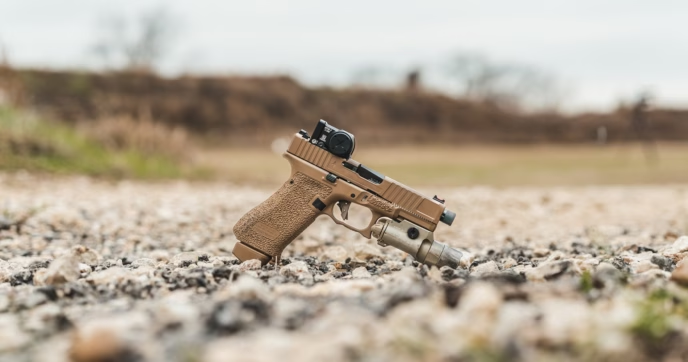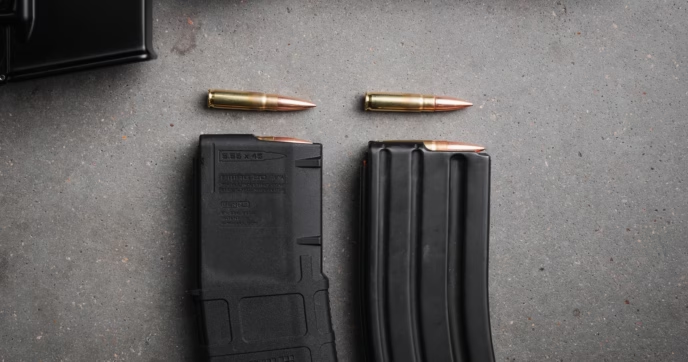Accurate fire at any range tends to rely primarily on the fundamentals: a good trigger press, proper stance and grip, and a clean sight picture. Once you start to get out past a few hundred yards, though, other factors start to join the fray. Your knowledge of your firearm’s ballistic drop and wind resistance becomes crucial, as does your ability to read your environment and make accurate calls. Perhaps the most critical, though, is stability.
That’s precisely where a rifle bipod comes in. It’s a simple piece of equipment—the most primitive versions being little more than two sticks and a bit of cord or tape to hold them together—but it can make a massive difference in the stability of your firing position. Modern versions offer adjustable leg length, panning, and tilt capability, allowing you to maintain a stable position even on uneven ground or while tracking a moving target.

Can You Put a Bipod on an AR-15?
AR-15s are among the most customizable rifles on the planet; nearly every accessory on the market has a version that is compatible with AR-15s, and that includes bipods.
Bipods can be installed on nearly any AR-15, attached by Keymod, MLOK, Picatinny, ARCA rail, or even by directly clamping to the barrel.
Adding a bipod to your AR-15 is an excellent way to increase its capability at range. By stabilizing your rifle and ameliorating the natural movement of your rifle caused by your body, you can shrink your groups and improve your hit percentage. The benefits at the range are obvious, but bipods have real applications in competition and field use, as well.
Consider, for example, the military MK12 SPR. While not technically an AR-15, it’s a very similar rifle used primarily in a semi-automatic firing mode for precision fire at extended ranges. As a precision rifle, it differs from standard military carbines in several ways, but the most salient one in this case is the inclusion of a bipod. Every MK12 is issued with one for the same reason you might want to include on your AR-15.
A good quality bipod offers the ability to fully stabilize your rifle in nearly any environment. Good bipods generally offer adjustable leg length, allowing you to fine-tune the height of your rifle if you need to clear tall grass or get lower to the ground for a more stable shot. The legs are usually independently adjustable, as well, and may be augmented by an adjustable tilt setting, letting you true your rifle to eliminate cant even from unlevel firing positions.
Bipods also offer a way to offload your rifle’s weight when observing an area for an extended period, such as when hunting from a blind. You can achieve a similar effect by placing the fore-end of your rifle on a tree branch or blind windowsill, but neither offers the stability of a bipod. For short- to medium-range shots, you may be able to get away with the former, but if you plan on doing any long-range hunting, a bipod is a worthy investment.

Where Do You Put a Bipod on an AR-15?
Generally, the best place for an AR bipod is as far forward on the rifle as possible. The further forward the bipod is located, the more stable the rifle will be when it is deployed. However, there are certain scenarios where you may not want the bipod fully forward.
In the case of pannable bipods (bipods that allow the rifle to be twisted left or right without moving the legs of the bipod), the size of the area that can be covered by panning is inversely correlated to how far forward the bipod is mounted. The further forward your bipod is, the less area you will be able to cover by panning. In this case, it may make sense to move your bipod farther back on your rail if the ability to pan over a large area is important for your use case.
In most other cases, the bipod should be mounted as far forward as possible. This position will maximize stability and typically keep the bipod out of the way of your firing grip.
Traditionally, bipods are installed with legs facing forward. This is primarily because early bipods were spring-loaded and mono-directional; they folded down from the front and could be stowed by simply pushing the legs forward until they folded up.
This made them quick to stow and deploy but required them to be mounted legs-forward. To do otherwise would be to risk the legs collapsing while loading the bipod during firing or under the force of recoil.
Many modern bipods feature a locking mechanism to keep the legs deployed, mooting the original purpose of mounting in a legs-forward position. For these types of bipods, it’s perfectly fine to mount them in a legs-rearward configuration on most rifles. For spring-loaded bipods without a lock, the legs-forward configuration should still be used.

AR-15 Bipod Mounting Options
Bipods are available for nearly every mounting interface found on AR-15 handguards. Some models of bipod, such as Magpul’s iteration, are available in different versions, each with different compatibility. Others, such as most of the Atlas Bipod’s lineup, can accept interchangeable bipod mounts.
MLOK, Keymod, Picatinny, and MOE bipods are all commonly available from various brands.
Recently, the ARCA rail mounting system and its variants, such as ARCA-Swiss, have become popular as a mounting option. These types of rails offer rapid reconfiguration and greater fine-tuning of exact placement but typically weigh more than other, more limited mounting options. ARCA rails are most common on precision rifles but are available for AR-15s as well.
Certain bipods, including many of those manufactured by Harris Bipods, utilize a sling swivel stud mounting system. This type of mount clamps to a sling swivel stud, as the name would suggest, and braces against the stock of a rifle. They are typically designed for use on more traditional rifles with wood or polymer stocks.
While AR-15s don’t typically feature these types of sling swivel studs, adapters are available to allow these types of bipods to be used with standard AR-15 interfaces such as Picatinny and MLOK.
In most cases, the type of mounting system is largely irrelevant; simply select a bipod that is compatible with the mounting system already offered by your rifle. However, some users may appreciate the additional utility of an ARCA rail.
Additionally, while QD attachment systems are available for Picatinny mounts, most other types of interfaces require tools to install or remove the bipod. Most users who require QD functionality opt for a Picatinny attachment system, which can be easily used with a Keymod or MLOK handguard by installing a short section of Picatinny rail.

Bipods for AR-15s
The field of AR-15 bipods is as varied as every other category of AR-15 accessory; there are dozens of manufacturers and well over a hundred different models to choose from. Even amongst quality bipod makers, there are simply too many good models for us to cover all of them, but we’ll take a look at a few of the most common ones below.
Harris S-BRM
Harris Engineering is one of the oldest names in AR-15 bipods. They have a long history of being used by both competitors and police and military units and are popular for their rapid deployment and stowing capability, as well as for their rigid legs.
Both of these attributes are made possible by their spring-loaded design, which assists in deployment and creates tension in the legs when deployed, eliminating any possible play.
The S-BRM is one of Harris’s most popular models, featuring notched legs for more secure adjustment and swivel capability for fine adjustments to rifle cant on uneven terrain.
Like many Harris bipods, it’s designed to mount to a sling swivel stud, but versions with alternative mounting options such as the S-BRMP for Picatinny are available.
Magpul Bipod
Magpul is a brand that needs little introduction. After making a name for themselves producing some of the highest quality magazines on the market, they have now branched out into all manner of firearm parts and accessories—including bipods.
The Magpul bipod is a hybrid design that mixes aluminum and steel parts with Magpul’s rugged polymer for a lightweight and simple design that offers everything you need in a bipod and nothing you don’t.
[Shop All Magpul Bipods]
The legs of the bipod can be deployed by simply flipping them down into place, but lock once open, offering greater security against accidental stowing. The adjustable-height legs are also locking, and the bipod features both pan and tilt adjustment, controlled by a single large knob.
Magpul’s bipod is available in several different colors and mounting configurations, including MLOK, Picatinny, Sling Swivel Stud, and A.R.M.S. 17S-compatible for QD functionality.
Atlas BT10 R8
Another titan of the bipod industry, Atlas bipods have been popular with competitors and long-range precision marksmen of all types for years. Their bipods offer several unique features, including the ability to lock in either a legs-forward or legs-rearward position without removing the bipod or turning it around, and the ability to lock in a 45-degree position in addition to the standard 90.
Like other bipods, the Atlas BT10 R8 features adjustable legs for height. Adjustable pan and tilt are also standard features, as is the ability to automatically lock the legs in any position, whether stowed, deployed, or deployed halfway in a 45-degree orientation.
Unlike spring-loaded designs, the BT10 R8 features a certain amount of “wiggle” in the legs when deployed and locked in place. Some users find this play preferable, as it allows the operator to more directly feel the process of loading the bipod to prepare for recoil. Others find the play counterproductive to the process; ultimately, it will come down to each user’s personal preference.
Atlas bipods also feature removable feet that can be replaced with alternate designs, including grippy rubber for smooth surfaces or spiked metal for field use.

Conclusion
Adding a bipod to your AR-15 is a surefire way to increase your stability and practical accuracy from a static position. While a more stable position can sometimes be found in the field by resting your rifle against a rock or tree, bipods offer unmatched stability across a wide range of environments and scenarios.
While selecting a bipod may seem intimidating, it’s mostly a matter of making sure that your chosen bipod can interface properly with the mounting system on your rifle’s handguard. Beyond that, all you need to do is find the best AR-15 bipod to match your needs and preferences.





